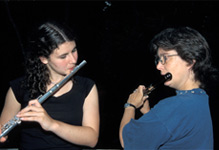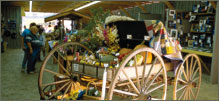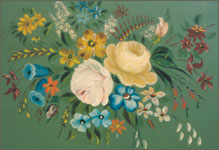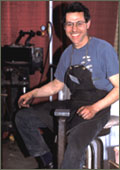Over the last two hundred years, many of the terms concerning folklife and traditional arts have been defined in slightly different ways by different groups of people.
The Traditional Arts Program of the New Hampshire State Council on the Arts bases its definitions for many terms on the work carried out by:
- Traditional Arts Program of the National Endowment for the Arts
- American Folklife Center at the Library of Congress
- Center for Folklife and Cultural Heritage at the Smithsonian Institution

Master artist Sarah Bauhan (left)
teaching Irish flute to
apprentice Sarah Nash.
apprenticeship grants - Many state arts agencies have Traditional Arts or Folk Arts Programs that are devoted to supporting traditional and folk arts in their states. Some of these statewide programs are housed at universities or historic associations.
One of the most important grant categories administered by these programs is called Apprenticeships. The purpose of these grants is to assist in the perpetuation of traditional arts by supporting a master traditional artist to teach an experienced apprentice for a defined period of time, usually 6 - 12 months. Funds in the grant cover master artist fees, supply costs, and travel costs essential to the project. The team sets out goals and skills they wish to cover during their time together.
Apprenticeships are funded in a wide variety of traditional art forms including music, dance and crafts.

Home arts display at the
Hopkinton State Fair.
archive - This is generally a location where written materials, images, and sound recordings can be stored in a professional way that protects them and assures their preservation. Archives usually have ways for the public to access their collections, either on-line or by physically being able to see, hear, and review the materials in person. In New Hampshire archives are housed at many large and small institutions. Here are just a few:
- New Hampshire State Library, Department of Natural and Cultural Resources
- Milnes Special Collections at the Dimond Library, University of New Hampshire
- New Hampshire Historical Association
- Lambert Library, Fanco-American Centre (Manchester)
cultural community - A cultural community shares the same country of origin, ethnicity, language, geographic area, way of life, or occupation.

Painted flowers on a metal tray
by Helen Learned.
community scholar - This term is used by folklorists to refer to people who have a personal interest in documenting and studying cultural activities, but do not necessarily have academic training in folklore or a related field. Public sector folklorists often work in partnership with community scholars who are connected with local historic societies or community-based organizations. Working together, folklorists and community scholars can identify, document, and organize public programs for local tradition bearers.
documentation - This term refers to ways that folklorists and community scholars make permanent records of the activities of cultural communities and individual tradition bearers. The most common ways to document are audio recordings, photographs, videotape, and written notes. It is important to ask permission of the person before taking photographs and making recordings. If the documentation is to be used in a publication or an exhibit, then it is important to ask the person or people for their permission to use the materials in this way.
fieldwork - This term refers to going into a community to find out more about traditional activities, people, and places. It often involves going to places where local communities gather-stores, social clubs, churches, etc. It also involves asking people if you can visit them in their homes. It is important that fieldworkers dress and speak respectfully when in a local community or person's home and ask permission to make recordings or take photographs.
folk arts - These are artistic expressions that have grown through time within a group or community that shares a common location, occupation, religion, language, or culture. These "grass roots" arts can be found in every culture and are passed on from one generation to the next, usually through oral tradition, often by observing a master.
For example, a fiddle player may learn by playing along with older musicians at local community dances, a quilter may learn by helping her mother, a woodcarver may learn by observing his grandfather, and a storyteller often draws upon real life experiences growing up in a particular region or neighborhood.
Folk arts reflect a community or a group's sense of beauty. The contributions of an individual artist's creativity woven into the tradition. Most people within a community will recognize and share pride in a traditional craft, style of music, or type of dance that is from that community. By looking closely, it may be possible to recognize the distinctive patterns of particular craftsmen, or the unique and lovely movements of a particular dancer.
Folk arts are often made for, shared with, and enjoyed by families, friends and neighbors. Craftsmen sometimes invest a great deal of time and special materials in folk arts that are intended for special people or special uses--like worship or ceremonial use. In traditional communities, some folk arts circulate between people without the exchange of money. Other folk arts are sold and exchanged through lively commerce at public markets and specialty stores.

Blacksmith
Gary Kalajian.
folklife - Folklife is a very broad term and usually refers to the cultural expressions of communities. Folklife is expressed in the way communities cook their food, farm, work with animals, decorate their yards, engage in time-honored occupations, make music, make crafts, celebrate life events, tell stories and even exchange jokes.
folklore - This refers to the oral traditions of a community, expressed in legends, myths, stories, jokes, and ways of speaking.
folklorist - A person trained in the study of folklore. Folklorists can work in a variety of settings including public agencies or non-profit organizations. They may also teach at a university or college or work as an independent contractor.
folk music - Folk music emerges from a community and reflects the ideas, emotions and outlook of the people in the community. Traditional folk music is often played on acoustic instruments that have also emerged from the community-for example: fiddles, hammer dulcimers, banjos, mandolins, drums, flutes, whistles, and cymbals. It can also be played on more modern electrified instruments like guitars and keyboards. Traditional instruments are sometimes made by craftsmen who become well respected and loved for their skills and sensitivity to the beauty of acoustic sound. Folk music incorporates folk song, which is often sung unaccompanied (without a musical instrument).
Note on "folk music": Beginning in the 1940s '50s, a number of young musicians drew inspiration from older forms of American music and began performing for larger audiences. This "folk revival" brought increased attention to traditional music, especially songs. Radio and record labels began to refer to this style of music as "folk music." Singers who were writing their own original compositions ("singer/songwriters") were grouped in with this phenomenon. Today, the term is used by some sectors of the commercial radio and recording world to refer to any music performed on acoustic instruments.
folk tales - Stories that are handed down verbally from generation to generation within a community.
interpretive materials- This refers to a range of educational materials that are developed to accompany public presentations-such as exhibits and performances. These materials can be pamphlets, brochures, photographs, exhibit signs and labels, videotapes, etc. and are intended to help people understand more about a tradition. Interpretive materials can provide information on the cultural history of a tradition such as: where it originated, when it first developed, how it has changed over the years, what are the essential characteristics, how it is enjoyed today, and who are the tradition bearers that preserve it.
research - This refers to the ways that folklorists and community scholars find out about traditions. Research can be done in a library using books, original documentation materials such as reports written by other researchers, photographs, audio recordings, etc. Research can also be carried out in the "field," which means working right in a community, visiting peoples' homes, taking photographs, making recordings, and writing down observations.
traditional arts - This is a broad term for the artistic activities that are passed down from one generation to the next. These can include traditional music, dance, crafts, and local architectural styles. Traditional arts can also include the classical arts of a culture, which are artistic traditions that come out of formalized study of the art form and usually developed for presentation to the upper classes of a society or royalty. Traditional arts include folk arts, a term that more specifically refer to grass roots community traditions.
tradition bearer - This refers to a person who is an authentic representative of a particular tradition, having learned it through a direct connection to the community or group from which the tradition emerged.
The loving and skilled hands of tradition bearers.

Grafting an apple tree

Planing a canoe

Blacksmithing
Photo credit: Lynn Martin Graton
New Hampshire State Council on the Arts
19 Pillsbury Street - 1st Floor, Concord, NH 03301


